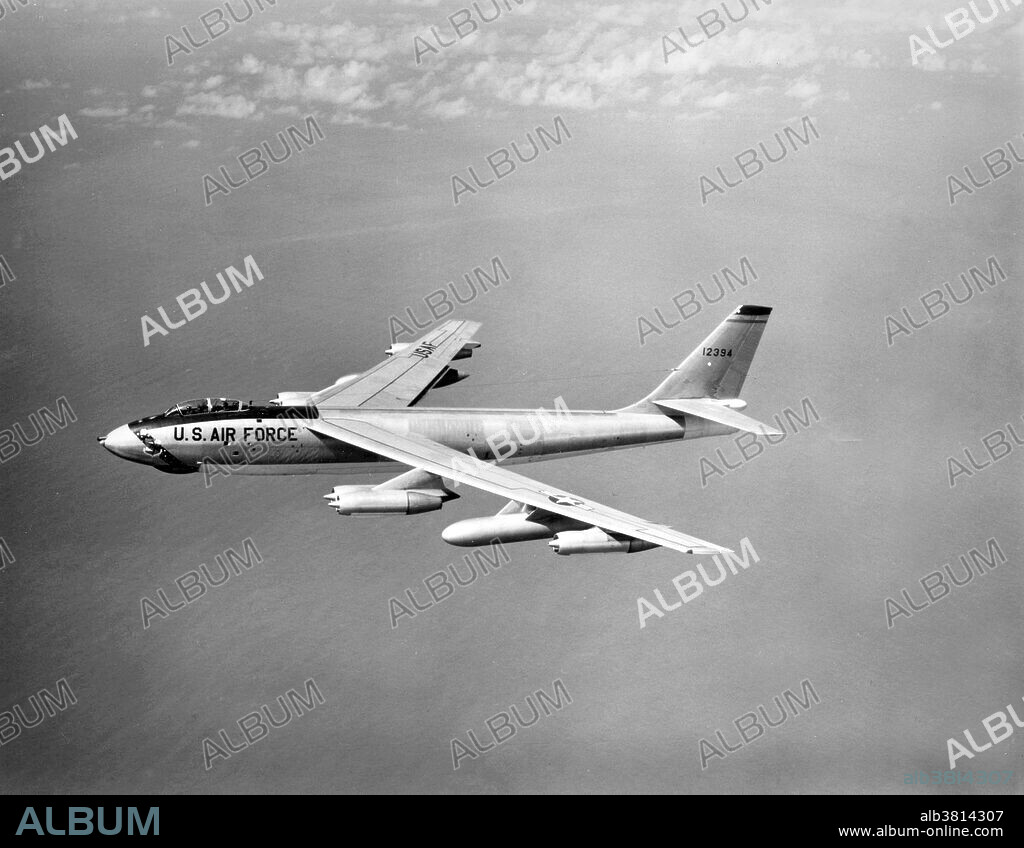alb3814307
Boeing B-47 Stratojet, Wing-Swept Bomber, 1956

|
Add to another lightbox |
|
Add to another lightbox |



Title:
Boeing B-47 Stratojet, Wing-Swept Bomber, 1956
Caption:
An overall view of a Boeing B-47 Stratojet aircraft in flight. The world's first swept-wing bomber. April 7, 1956. The swept-wing bomber has a top speed of more than 600 miles an hour. It is powered by six General Electric J-47 turbo-jet engines, has a maximum gross takeoff weight of more than 186,000 pounds and can carry more than 20,000 pounds of bombs. The Boeing B-47 Stratojet (company Model 450) was a long range, six-engine, turbojet-powered strategic bomber designed to fly at high subsonic speed and at high altitude to avoid enemy interceptor aircraft. The B-47's primary mission was to drop nuclear bombs on the Soviet Union. With its engines carried in nacelles under the swept wing, the B-47 was a major innovation in post-World War II combat jet design, and contributed to the development of modern jet airliners. The B-47 entered service with the United States Air Force's Strategic Air Command (SAC) in 1951. It never saw combat as a bomber, but was a mainstay of SAC's bomber strength during the late 1950s and early 1960s, and remained in use as a bomber until 1965. It was also adapted to a number of other missions, including photographic reconnaissance, electronic intelligence and weather reconnaissance, remaining in service as a reconnaissance aircraft until 1969 and as a testbed until 1977.
Credit:
Album / Science Source / U.S. Air Force
Releases:
Model: No - Property: No
Rights questions?
Rights questions?
Image size:
4200 x 3259 px | 39.2 MB
Print size:
35.6 x 27.6 cm | 14.0 x 10.9 in (300 dpi)
Keywords:
1950S • 1956 • 20 XX TWENTIETH CENTURY • 20TH CENTURY • 20TH • AERONAUT • AERONAUTICAL • AERONAUTICS • AIR FORCE • AIRCRAFT • AIRFORCE • AIRPLANE • AIR_FORCE • AMERICA • AMERICAN • AVIATION • B-47 STRATOJET • B-47 • BOEING B-47 STRATOJET • BOMBER AIRCRAFT • BOMBER • BW • FIRST WING SWEPT BOMBER • FIRST WING-SWEPT BOMBER • FLIGHT • FLYING • HISTORIC • HISTORICAL • HISTORY • JET • JET-POWERED • LUFTWAFFE • MILITARY AIRCRAFT • PENETRATION BOMBER • PHOTO • PHOTOGRAPH • PLANE • SCIENCE • SIX-ENGINE • STRATEGIC BOMBER • STRATEGIC BOMBING • STRATOJET • SWEPT WING • SWEPT-WING • TECHNOLOGICAL • TECHNOLOGY • TRANSPORT • TRANSPORTATION • TURBO-JET MILITARY • TURBO-JET • TURBOJET-POWERED • TWENTIETH CENTURY • UNITED STATES • US • USA • USAF
 Pinterest
Pinterest Twitter
Twitter Facebook
Facebook Copy link
Copy link Email
Email

